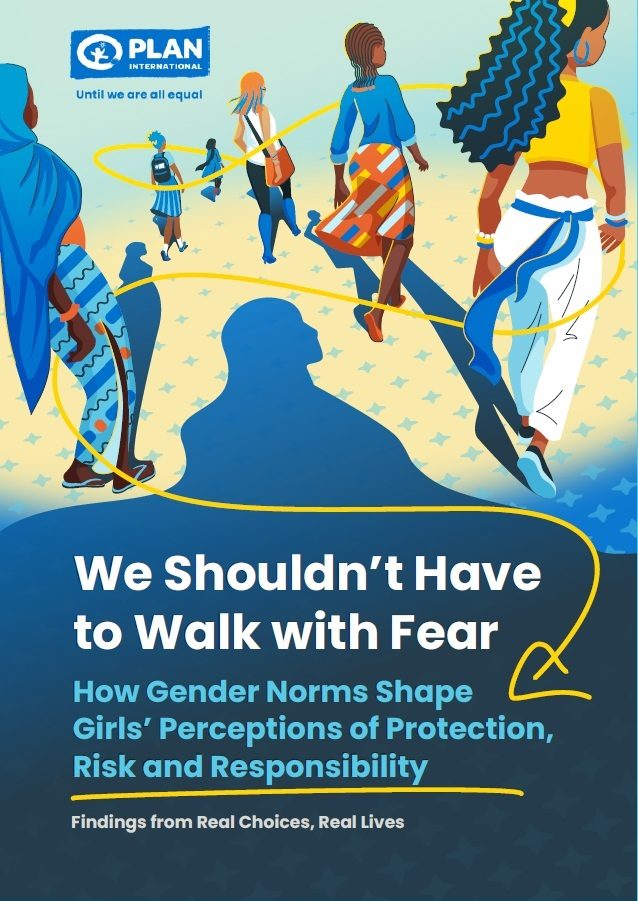Real Choices Real Lives: “We Shouldn’t Have to Walk with Fear”
How Gender Norms Shape Girls’ Perceptions of Protection, Risk and Responsibility
This report explores how social norms influence girls’ beliefs and attitudes about gender-based violence.

Through our qualitative and longitudinal research study, Real Choices, Real Lives, Plan International has been following the lives of 142 girls across 9 countries – Benin, Brazil, Cambodia, Dominican Republic, El Salvador, Philippines, Togo, Uganda, and Vietnam – from their births in 2006 through to age 18 in 2024.
By tracking their experiences over the years, Real Choices, Real Lives provides insight into adolescent girls’ attitudes and beliefs about gender-based violence (GBV). Deeply rooted in harmful gender and social norms, the scale of GBV is devastating, affecting one billion girls and women globally with severe and long-lasting consequences. Our research explores how girls internalise and reproduce harmful norms as they grow up, and how rigid social expectations about how girls should act and behave (enforced upon girls in the name of their safety) limit girls’ mobility, self-confidence and rights.
Adolescent girls are uniquely vulnerable to GBV: not only do they experience distinct forms of violence such as child marriage and female genital mutilation, they are also at heightened risk of sexual violence and intimate partner violence. By the age of 11, 91% of the Real Choices, Real Lives cohort girls had experienced some form of gender-based violence (GBV).
“[I feel unsafe] fetching water from borehole at night. […] Because bad men may rape me.” – Jane, age 12 (2018), Uganda
Adolescence is also a time when gender and social norms are rigidly imposed on and internalised by girls. Because of this, adolescence offers a crucial window for preventing GBV against girls and women, and for breaking cycles of inequality.
“We shouldn’t have to walk with fear, be careful when we walk; but [instead], others have to respect us.” – Gladys, age 17 (2024), El Salvador
Hear from the girls in their own words
Download the report – English
2.25 mb
Download the report – French
2.80 mb
Download the report – Spanish
2.44 mb
“They say that when you wear very short clothes it provokes the boys.” – Saidy, age 15 (2021), Dominican Republic
Learn more about the girls’ experiences from our case studies
Jasmine and gabriela's stories
314.64 kb
Key findings
- From an early age, girls internalise harmful beliefs—including the idea that male violence is ‘natural’ or inevitable. In early adolescence, the majority of girls (68%) believe that male violence is natural or ‘just the way things are’.
- The internalisation of these harmful gender norms reinforces gender inequality and directly increases girls’ risk of experiencing violence, especially intimate partner violence.
- In early adolescence, 57% of girls believe that it is their own responsibility to protect themselves from violence and abuse. This belief strengthens to 67% by the end of adolescence, underscoring the urgency of challenging harmful norms before they become more deeply entrenched.
- These beliefs erode girls’ confidence in their ability to make their own decisions, limit their freedoms, and undermine their belief in equal rights for girls and boys.
- But as they grow older, some girls reject the belief that violence is inevitable and call for equal freedoms and rights. As they entered adulthood, 89% of young women firmly believed that parents could teach boys not to be violent or aggressive.
- Girls are speaking out against inequality and demanding that adults and institutions listen and act.
“We have the right to speak out and we have reason enough to speak.” – Davy, age 17 (2024), Cambodia
Recommendations for change
Ending GBV is essential to achieving the Sustainable Development Goals, particularly Goal 5, aimed at “achiev[ing] gender equality and empower[ing] all women and girls”. To create this change:
- Governments, donors and civil society must urgently increase funding for programmes that challenge harmful gender norms, prioritising initiatives to end violence and promote gender equality.
- Governments, donors, and civil society must invest in strong prevention services that are built to last. This means making sure that shelters, crisis centres, and support services have long-term funding, training staff to understand and respond to GBV, and including girls and communities in shaping these services so they truly meet their needs.
- Governments must act urgently to counter the rollback of rights by enshrining gender equality and human rights in legislative and executive policy.
- Governments must consult and include girls in the design and monitoring of prevention and protection systems.
“It is very good to listen to a girl child. A girl child should be given a platform to speak what she is going through and also get solutions for how other girls can be supported especially those who cannot speak for themselves.” – Amelia, age 15 (2021), Uganda
Categories: Protection from violence


